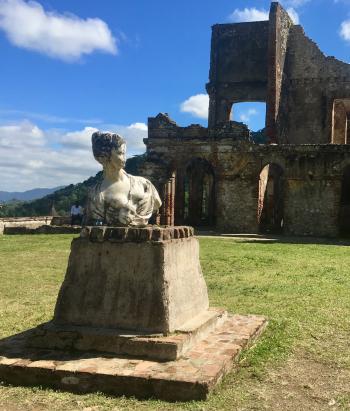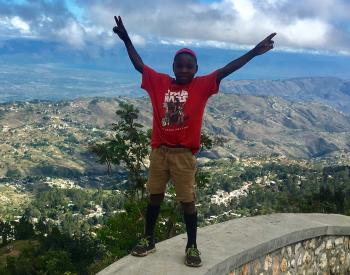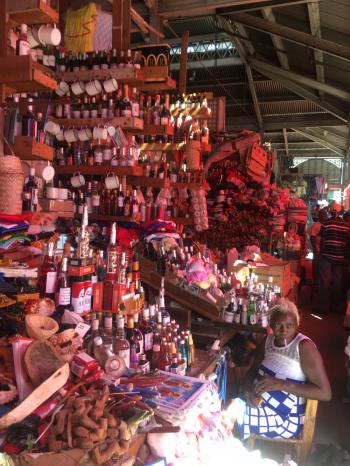Getting a different view of Haiti
This article appears on page 32 of the May 2018 issue.
Does the thought of Haiti conjure up images of poverty, famine and earthquakes? Well, think again, because that’s only a part of the picture. A vibrant nation with colorful traditions, delicious food and friendly people, Haiti is waiting to be discovered.
An introduction
When my two travel companions, who are voracious country counters, and I sailed my yacht, Serendipity, from Guadeloupe to Hispaniola, stopping briefly on Aves Island, our thoughts immediately turned to visiting Haiti. I had previously spent a week there, volunteering in a refugee camp along its frontier with the Dominican Republic, but this would be a first for them.
We contacted Jacqui Labrom at Voyages Lumière (phone +509 3607 1321, voyageslumiere.com), who arranged a wonderful, whirlwind 4-day tour for us.
To more completely immerse ourselves in the dual national cultures of Hispaniola, we decided to take a public bus from Santo Domingo to Port-au-Prince. Crossing an overland border always has the potential of being an adventure, and this one did not disappoint, with multiple forays off and back on the bus accompanied by long queues at Immigration and Customs.
Arriving at the bus terminal in Port-au-Prince, we were met by one of Jacqui’s drivers, who gave us a short preview tour of Port-au-Prince before dropping us off at Le Plaza Hotel. He also made sure that everything was to our satisfaction before he left us. We shared a more-than-adequate room, costing $125 per night including full buffet breakfast.
Port-au-Prince
The first half of our second day was spent touring the majestic hills overlooking Port-au-Prince, where we saw several of the palatial homes belonging to the diplomatic corps and explored the beautiful nature in the milder climate of the hillside.
The second half was spent exploring Port-au-Prince and getting to know its wild character. Stops along the way included several of the charming gingerbread houses, the National Museum and the stranger-than-fiction markets, including the infamous Iron Market, where voodoo objects are for sale.
That night, Jacqui came by our hotel to introduce herself and make sure that everything was going well. We enjoyed a scrumptious meal at our hotel and then retired to the balcony to watch the pre-Carnival parade and street party, both important Haitian traditions.
The next day, we took an early-morning flight to the northern peninsula, Cap-Haïtien. Sites there included the Citadel (an old fort), Sans-Souci Palace and the Notre-Dame Cathedral.
Lunch was in a small-town restaurant along the way before we caught our flight back to Port-au-Prince.
A night out
We decided to walk around the city before returning to our hotel, so we said good-bye to our driver and got lost in a street gallery displaying the works of local artists.
For dinner, we decided to eat at the landmark restaurant at Hotel Oloffson, managed by a Princeton-educated Haitian-American, and had our best meal yet. Located in an exquisite gingerbread house, the restaurant was decorated with antique voodoo curios from Haiti. The food and service were excellent and the prices, quite reasonable (in the $15-$20 range).
We decided to do as the locals do, so we took motorcycle taxis to the restaurant and back to our hotel, each of us paying about $1 each way.
We made an early night of it to prepare for the next day’s bus ride back to the Dominican Republic and the awaiting Serendipity.
The details
We never felt threatened or intimidated during our brief stay in Haiti, but a small group of artists did get somewhat aggressive in trying to get us to look at their artwork; we interpreted this as being due to the paucity of tourists available to buy their work. The usual modicum of common sense is in order when venturing out on your own. Stay within areas that are well lit and frequented by locals.
All of our guides and drivers spoke English, to a greater or lesser extent, and could not have been friendlier or more accommodating. I took every possible opportunity to practice my French.
We paid $760 each for our visit, which included our hotel with buffet breakfast, the internal flights, lunch in Cap-Haïtien and all guides and drivers. Unsure about tipping, we left about $10 per day per driver and guide.
If you haven’t yet visited Haiti, or don’t know anyone else who has, you’re not alone, but I strongly believe that Haiti is ripe for discovery by savvy travelers looking for a fascinating destination devoid of the hordes present elsewhere in the Caribbean.



